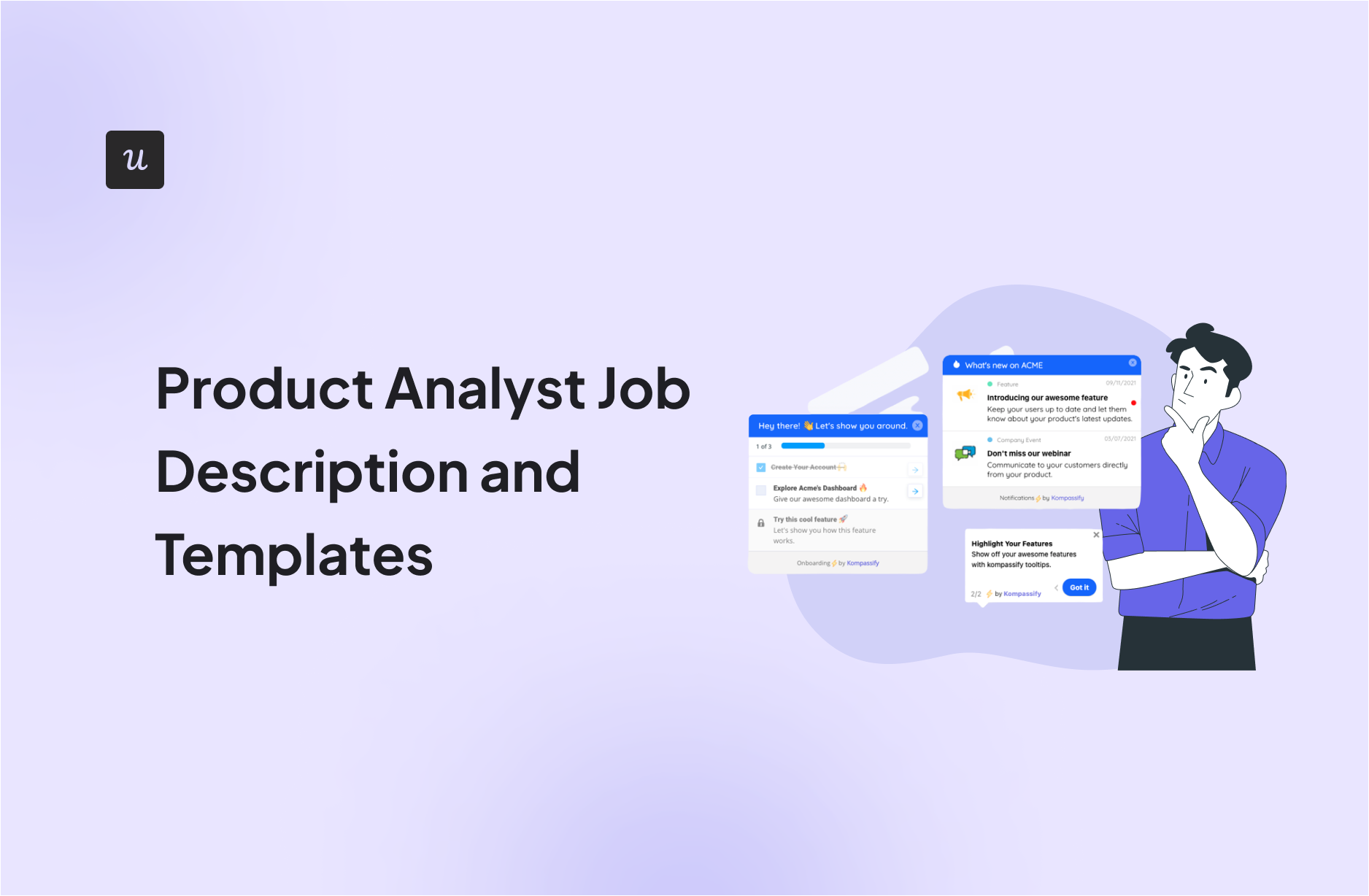
Interested in product analyst roles? You’re in the right place!
In this guide, we’ll explore the ins and outs of product analyst roles through detailed job descriptions and handy templates. Whether you’re hiring, job hunting, or simply curious, we’ve got you covered with practical insights and ready-to-use resources.
Let’s dive in!
Try Userpilot Now
See Why 1,000+ Teams Choose Userpilot

What is a product analyst?
A product analyst is a professional who conducts product research, analyzes, and interprets such data to make accurate decisions about the product. Product analysis involves two major things: the product and the data.
The product analyst is a crucial role in a company because it helps you gain an understanding of your product about the user which is important to drive enough sales and grow as a company.
Product analyst’s main responsibilities
The responsibility of a product analyst can be summed up as providing insights that drive accurate and data-driven decisions. Without the product analyst, stakeholders are left to make important decisions based on guesswork.
Here is a detailed breakdown responsibilities and duties of a product analyst:
- Carrying out adequate customer research and gathering data about the use to analyze customer behavior.
- Carrying out extensive market research to identify patterns and trends that serve as pointers for product strategies.
- Making inferences from data obtained and reporting it to stakeholders in a simple and visualizing way.
- Monitoring the product market performance and proposing necessary changes.
- Assist in developing the product roadmap, aligning it with company goals, market trends, and customer requirements.
- Collaborate with cross-functional teams, including engineering, marketing, sales, and customer support, to ensure successful product delivery and adoption.
- Monitor competitor products and strategies, identifying strengths, weaknesses, and opportunities for differentiation.
- Establish and maintain a structured feedback loop with customers, internal stakeholders, and other relevant parties to gather insights for continuous product improvement.
Product analyst job description and template
Here is a typical product analyst job description template:
Position Overview:
The Product Analyst will play a key role in our product development and management process by analyzing market trends, customer feedback, and product performance data to drive informed decision-making. The successful candidate will collaborate closely with cross-functional teams including product management, engineering, marketing, and sales to identify opportunities for product improvement and optimization.
Responsibilities:
Data Analysis and Interpretation:
- Collect, organize, and analyze product performance data using various analytical tools and techniques.
- Interpret data to uncover insights into user behavior, market trends, and product performance metrics.
- Develop and maintain dashboards, reports, and other tools to visualize and communicate key findings to stakeholders.
Market Research and Competitive Analysis:
- Analyse competitor products and strategies to identify strengths, weaknesses, and opportunities for differentiation.
- Monitor market dynamics and provide recommendations for product positioning and feature enhancements.
Product Performance Tracking and Reporting:
- Track key performance indicators (KPIs) related to product usage, adoption, and customer satisfaction.
- Generate regular reports and presentations to communicate product performance metrics and trends to stakeholders.
Cross-Functional Collaboration:
- Collaborate with product management, engineering, marketing, and sales teams to align with product priorities and roadmap.
Continuous Improvement and Optimization:
- Identify opportunities for product optimization based on data-driven insights and customer feedback.
Qualifications:
- Bachelor’s degree in Business, Economics, Statistics, Computer Science, or a related field. Advanced degree preferred.
- X years of experience in data analysis, business intelligence, or product management roles.
- Proficiency in data analysis tools such as SQL, Excel, Python, Power BI, or similar tools.
- Strong analytical and problem-solving skills with a keen attention to detail.
- Excellent communication and presentation skills, with the ability to transform complex findings into clear and actionable insights.
- Experience working in cross-functional teams and collaborating with stakeholders at all levels of the organization.
- Knowledge of product management principles and practices is a plus.
- Experience with product analytics platforms such as Google Analytics, Userpilot, Mixpanel, or Amplitude.
Best practices to be a great product analyst
Here are the top five best practices for being a great product analyst:
- Setting SMART goals and KPIs: The product analyst role ranges from research, analysis and interfacing with other product professionals and stakeholders effectively. This creates the need to set goals that are specific, measurable, achievable, relevant, and time-bound to keep you in line and help you monitor your performance.
- Attention to detail: A product analyst must be able to spot a product trend by paying attention to details.
- User-centric mindset: A product analyst puts themselves in the shoes of the user in every stage of the product lifecycle.
- Ability to incorporate customer feedback: Incorporating customer feedback makes you develop and make appropriate iterations to your product for better customer retention.
- Getting skilled with product analysis tools: Getting proficient in product analysis tools like Userpilot is one factor that can give you an advantage and provide you with more accurate and specific insights.
Product analyst FAQs
- Who can become a product analyst?
Anyone can become a product analyst by learning the necessary skills and experience. However, although it is not stringent, most recruiters add a degree in business, statistics, or economics to job requirements.
- Is product analyst a technical role?
The product analyst role is partially a mix of technical and soft skills. You need to learn how to use data analysis tools like SQL, Power BI, Excel, and Tableau and product analytics tools such as Userpilot and Mixpanel to make some headway in your career.
- What is a product analyst vs a data analyst?
A product analyst is like a niche in data analytics. A product analyst focuses on a product while a data analyst works on data generally.
- What is the role of a product business analyst?
A product business analyst helps to ensure that the product is aligned with customer needs and, when needed, based on customer feedback, suggests possible product iterations for customer retention.
Conclusion
We hope this guide has provided you with valuable insights into the roles and responsibilities of product analysts.
By understanding the key responsibilities and skills required, you can make informed decisions and take meaningful steps in your career or recruitment journey.
Looking into tools for product analysts? Userpilot is an all-in-one product platform with engagement features and powerful analytics capabilities. Book a demo to see it in action!






